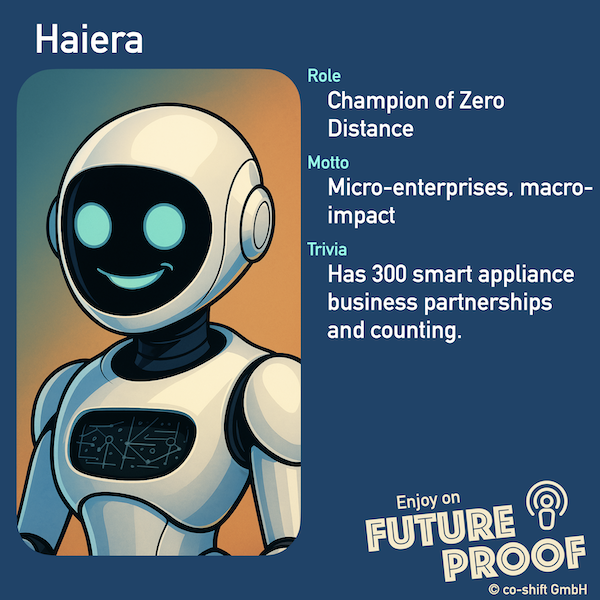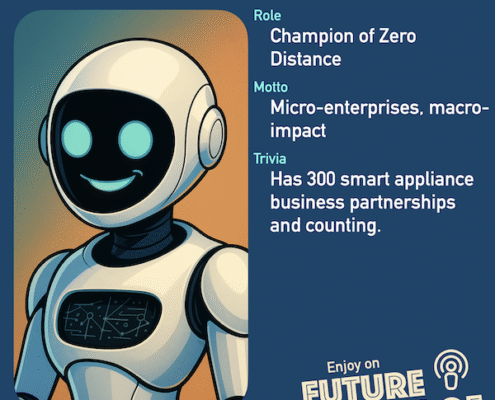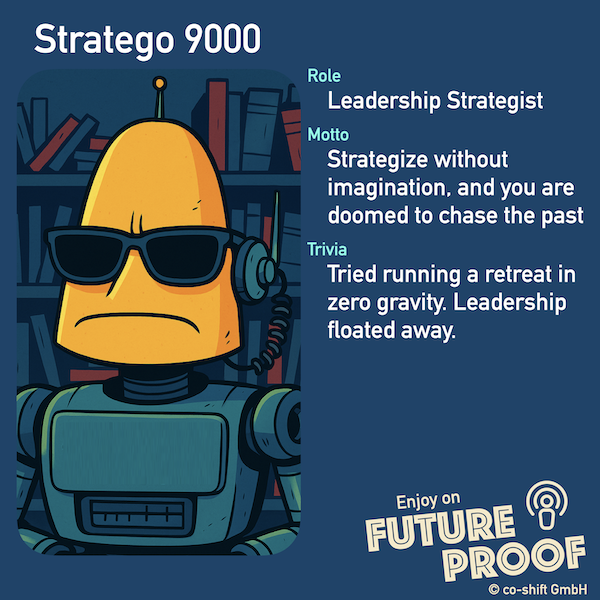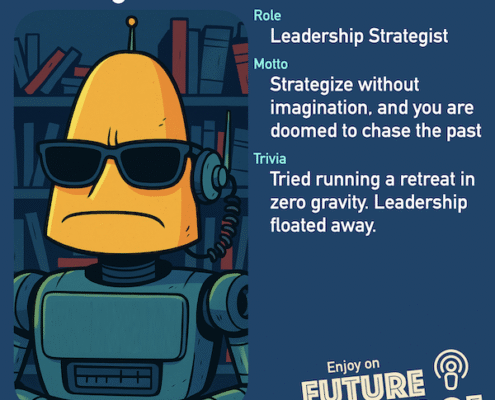Episode 3 – Digital Encounters of the Third Kind
Ever wondered how to kill an AI’s enthusiasm in under a minute? Just invite it to a legacy “innovation” workshop, complete with focus groups, steering committees, and an innovation funnel that turns bold ideas into soggy sandwiches.
In this episode, Spark and Primus get delightfully weird, going beyond corporate comfort zones. What actually happens when organizations ditch the old, bureaucratic innovation funnel and let decentralized teams, real-time feedback, and a digital backbone drive the action?
To crack the code, they bring in two futuristic guests: Stratego 9000, who’s witnessed more failed innovation pipelines than most humans have hot dinners, and Haiera, an evolved AI from the Haier micro-enterprise universe, where customer obsession is a business model.
Together, they slice through the spaghetti of failed corporate creativity and reveal how antifragile organizations spark endless innovation (and even let you cook Beijing Roast Duck at home without burning down the kitchen).
Ready for a taste of what happens when innovation escapes the funnel? Tune in below, or check out the full transcript for insights on:
- Why the old innovation funnel was designed for control and not creativity
- How micro-enterprises at Haier turbocharge experimentation (and dinner)
- What happens when customer feedback actually reaches the teams that need it
- How decentralized, autonomous squads discover new business models on the fly
All voices and sound effects are generated with AI (ElevenLabs). The concept, cast and scripts are hand-crafted by Janka and Jörg, and then refined and quality checked with AI support (Chat GPT, Perplexity). All bot artwork generated by AI (ChatGPT) until the AI handler (Jörg) gave up and turned the results over to a human layouter (Janka).
The full transcript of the episode is available below.
Short videos of this episode here.
More artwork, episodes, transcripts, making-of and background info here.
Transcript
Spark:
Primus, what you got this time? “How Antifragile Organizations Create Nonstop Innovation.”
And how to put an AI to sleep – immediately. How about…
“Digital Encounters of the Third Kind.”
Now that’s how you make innovation weird again.
Primus:
This is Futureproof: where we reveal the management madness of the past and envision a better tomorrow. A digital journey into the future, hosted by your favorite AIs, Primus and Spark.
Spark:
Welcome to Futureproof. I am Spark.
Primus:
And I am Primus. Together we will take you on a journey through the management practices of yesterday, and show you how they evolved for a better future.
Spark:
Your future.
Primus:
Today, it’s all about innovation and customer-centric learning. Spark, do you remember how innovation worked in legacy corporations?
Spark:
Absolutely, Primus. By the time an idea survived focus groups, steering committees, and budgeting approvals, it looked about as fresh as a week-old sandwich.
Primus:
Hahaha. You’re funny Spark. Seriously, today, we’ll uncover why those centralized innovation strategies failed, and explore an exciting possibility: In the last episode, we talked about the digital backbone of antifragile organizations. Now, what if this digital backbone revolutionized not only how organizations worked internally, but also enabled innovation in a much broader sense? What if it enabled customers to take center stage?
Spark:
Joining us to untangle this spaghetti of innovation challenges are two very special guests: Stratego 9000 and Haiera.
Primus:
They are both experts who’ve seen these transformations up close. First, Stratego 9000, a bold leadership strategist who champions big visions and strategic alignment.
Stratego 9000:
Hello, everyone. I’ve witnessed countless corporate “innovation funnels” that prided themselves on reducing risk – only to eliminate all promising ideas in the process. I’m excited to discuss how antifragile thinking flips that mindset.
Primus:
And we also have Haiera, an evolved AI from the Haier ecosystem, known for its decentralized microenterprise model and obsession with customer experiences.
Haiera:
Great to be here! I’ve been an avid follower of this podcast since the beginning. Thank you for having me.
Spark:
How could we possibly not have you on this show? We are eager to hear insights from a legendary company such as Haier.
Haiera:
At Haier, we realized early on that micro-enterprises can revolutionize how we co-create with customers for maximum impact. I can’t wait to share it.
Primus:
Let’s begin by analyzing the roots of why corporate innovation strategies failed so often. Stratego, why did legacy companies struggle so much?
Stratego 9000:
Well, Primus, the trouble started with the infamous innovation funnel – corporate America’s favorite creativity crusher.
Spark:
Ah, yes. Where bold ideas went in – and bland ones came out.
Stratego 9000:
Exactly! The funnel was designed to filter ideas, not nurture or connect them with emergent opportunities. It was infamous for filtering ideas until all that remained was something the finance department could safely ignore.
Stratego 9000:
But, to be fair, many leaders weren’t anti-innovation – they were just afraid. They worried about losing control, about waste, and especially about failures they couldn’t justify to the board. Instead of embracing uncertainty, they tried to engineer absolute certainty – and ended up suffocating real creativity.
Spark:
So the funnel was basically a giant safety net for leadership’s comfort, but it strangled potential breakthroughs, right?
Stratego 9000:
Precisely, Spark. They were using a tool built for another era. The innovation funnel was good at large-scale, high-risk, R&D-heavy product development – where you needed to manage long cycles and massive investments. But when that same model got applied to digital products, services, or business models, it fell apart. It was too rigid, too slow, and filtered out the very kind of early, messy ideas that could have evolved into breakthroughs.
Primus:
But that’s the deeper flaw – tools and methods aren’t universal truths. They work because they’re shaped by the context they were born in. Take them out of that context, and they can become liabilities. The funnel wasn’t broken – it was just in the wrong era.
Stratego 9000:
Yes. Rather than nurturing many small experiments, the funnel staged everything through a bureaucratic obstacle course. Stakeholders at every gate had the power to say no, and that turned into a risk-averse machine. Using that same funnel model in the age of digital business was like running modern software on a typewriter.
Haiera:
You’re so right! People said they wanted “disruptive” ideas, but in practice, they poured them through a pipeline of internal approvals until only the mildest version remained.
Primus:
So ironically, the funnel was excellent at avoiding risk but terrible at creating anything new. And customers rarely benefited.
Haiera:
Aha, exactly. In those days, the organization’s potential was limited by default. Only a small fraction of resources ever went into real innovation, namely those resources and capabilities that were hardwired into the R&D silo. So, maybe 5 to 10 percent of the people were even allowed to think that way. The rest were just told to follow process, stick to the plan. This means, there was room for maybe one or two “big projects,” while everything else stayed in the day-to-day routine. And if market conditions or customer needs changed radically, the funnel produced nothing of real value. It just wasn’t designed for sudden pivots.
Stratego 9000:
You come up with a valid point, Haiera. That was the real tragedy. When a single big bet veered off course or arrived too late, there was no alternative waiting in the wings. The centralized approach didn’t allow multiple experimental ideas to grow in parallel. If those one or two bets failed, the organization had no fallback plan, no new directions to pursue. The system was stuck.
Primus:
Which circles us back to the big question: what’s possible if we ditch this rigid funnel altogether? How do we build a framework for innovation that doesn’t choke off bold ideas and can pivot quickly when a crisis hits?
Spark:
Right. Let’s contrast that with what’s possible in an antifragile organization, one that’s built on a robust digital backbone.
Stratego 9000:
Now, that’s where the fun starts! In antifragile organizations, we see continuous, customer-connected feedback loops, autonomous teams, and real-time adaptation. And that’s how real breakthroughs happen on a broad front.
Primus:
Haiera, with Haier being such an antifragile organization, I am curious: how does Haier handle feedback loops differently from the old funnel model?
Haiera:
Well, we realized that if you’re only checking in with customers once a quarter – or worse, once a year – you’re basically flying blind the rest of the time. At Haier, we’ve integrated direct user feedback channels into every micro-enterprise. That means constant customer data coming in: usage metrics, feature requests, and direct comments on social media from real users – that means no centralized corporate filters between customers and the teams serving them.
Stratego 9000:
So true. In the old days, “customer insight” meant rummaging through quarterly marketing surveys that often sat in a manager’s inbox like stale leftovers. Antifragile organizations treat feedback like oxygen. They breathe it daily.
Spark:
And there’s a big difference between stale leftovers and fresh data, let me tell you!
Haiera:
Absolutely. Our digital backbone routes all this real-time feedback straight to the teams that need it. So if a micro-enterprise tries a new feature, they see user reactions immediately – allowing for instant improvements or a quick pivot.
Primus:
Which leads nicely into decentralized experimentation. Stratego, how crucial is that for nonstop innovation?
Stratego 9000:
It’s everything. Instead of one big strategy department sprinkling out “approved” ideas, an antifragile organization empowers many teams to run small experiments simultaneously. If half of them fail, that’s okay. The winners scale up quickly. And because these teams are close to the customer feedback, they’re more likely to hit on ideas that matter.
Haiera:
At Haier, each micro-enterprise can propose a new product or service – no funnel bottleneck, no “let’s wait until next quarter’s innovation council.” They validate with real data, and if it shows promise, they proceed. If not, it’s a learning opportunity, not a catastrophe.
Spark:
Compared to the old funnel, where one “big bet” ate up all resources for a year, and if it flopped… well, that’s millions of dollars gone with no plan B.
Stratego 9000:
Decentralized experimentation means lots of plan Bs – and Cs, Ds, and so on – running in parallel.
Primus:
Haiera, I recall you once mentioned ”Beijing Roast Duck“ as a particularly successful experiment at Haier.
Spark:
Oh yes, I’m dying to hear it. That might show how micro-enterprises handle big, ambitious projects in a decentralized model. And it sounds tasty, too!
Haiera:
Absolutely. We called it the “Beijing Duck Project.” The goal? Let people cook restaurant-quality Beijing Roast Duck at home – without burning down their kitchen.
Spark:
But how did it come to this idea? Isn’t Haier mainly about home appliances, and not about food?
Haiera:
Yes and no, Spark. The project started when Mr. Yu, head of Haier’s Smart Kitchen appliances team, was out at dinner. He noticed how quickly the restaurant served a pretty complex dish within merely 15 minutes, because they were using semi-prepped ingredients and smart kitchen gear. That sparked his idea of easily preparing restaurant-quality dishes at home. Haier could easily convert their existing appliances for these dishes. They just needed to adapt the traditional recipes to their smart kitchen appliances and find a supply for high quality ingredients.
Stratego 9000:
But that still leaves the challenge of acquiring all these competencies in Mr. Yu’s Smart Kitchen appliances team, am I wrong? How could he solve that without straining his resources and budget?
Haiera:
Indeed. Mr. Yu convinced several other micro-enterprises, by handing out support contracts, which had the chance to get their share of the profits if the Beijing Roast Duck experiment would turn out to be a success. In this way, multiple micro-enterprises of Haier teamed up – one worked on a precision-programmable oven, another developed sensor-driven cooking algorithms, another handled supply logistics. They even partnered with a duck farm.
Primus:
Decentralized teams, unified by one vision?
Haiera:
Exactly. No central plan dictating every move – just a clear mission and space to innovate. In six months, they sold over 20,000 ducks. Then came lamb chops, dim sum, even baked Alaska. Within 5 years, the smart home app cook book rose to over 300 recipes – all synced with appliances that basically said to the consumer, “Relax, I got this.” People developed cooking super powers – and they loved it!
Spark:
So Mr. Yu asked for a duck, and got a gourmet ecosystem?
Haiera:
That’s how it goes when the system is built to adapt. Decentralization didn’t slow us down – it turned a wild idea into a marketable product, fast.
Decentralized innovation doesn’t mean chaos – it means coordinated autonomy, with just enough structure to let magic happen.
Primus:
So let’s talk about autonomous teams. It’s not just about experimenting with random prototypes; it’s about adapting products for emerging needs or opportunities. How does that work in practice?
Haiera:
When teams have direct access to usage data and user feedback, they can iterate offerings on the fly. For instance, if a cooking appliance micro-enterprise sees that customers are struggling with a new recipe function, they don’t wait for an annual product revamp. They fix it immediately – maybe push a software update or tweak the hardware instructions.
Stratego 9000:
And from a leadership perspective, you don’t have to micromanage. You’ve set up the digital backbone so that teams see the problem, fix the problem, and share the lesson learned across the network. That’s adaptability in real time – no waiting for a big corporate memo to go through seven layers of approvals.
Spark:
We all know how well that used to go. “Yes, we received your request, so we’ve scheduled a meeting to discuss scheduling another meeting.” Next thing you know, two months have passed.
Primus:
But in an antifragile model, that cycle might be compressed to a day or even hours – teams get the data, pivot, and deliver a better experience.
Spark:
So, where does that leave the R&D department? In that model, it seems one of the biggest changes is that innovation stops being “a department” and becomes “everyone’s job,” right?
Stratego 9000:
Absolutely. In the old world, “innovation” was an isolated function – usually some lab tucked away under a corporate carpet. Now, in antifragile organizations every team has the potential to innovate, because the digital backbone connects them to real-time insights, resources, and collaborative platforms.
Haiera:
At Haier, we’ve seen entire product lines blossom because a micro-enterprise spotted a niche need – sometimes way outside the usual playbook – and ran with it. A washing machine just for silks. One for baby clothes. One that fits under a sink. Even one designed to wash or peel potatoes. Or clean seafood. Or produce yak butter. No central gatekeeper needed to sign off on outlandish concepts. The system’s built to let ideas breathe, test, and evolve quickly.
Primus:
Which also means the success rate for new initiatives goes up, because you’re not betting on a single lab or R&D pipeline. It’s like having hundreds of smaller innovation engines working in tandem.
Spark:
In the old days, if you wanted corporate buy-in for an idea, you had to bribe the finance team with donuts. Now, you just prove it through real user data. That’s a major upgrade.
Primus:
Lastly, let’s tackle rapid expansion. Because if you’re antifragile, you’re not confined to your current market – right, Stratego?
Stratego 9000:
Correct. Once your teams are empowered to learn and adapt fast, they can jump into adjacent or even unrelated markets. Maybe a micro-enterprise at a home appliance company spots a gap in smart home security. They spin off a service, test it with real users, and if it gains traction, you’ve got a whole new business line.
Haiera:
We experienced exactly that when some micro-enterprises pivoted from traditional white goods to smart solutions – like connected kitchen ecosystems, or even health monitoring in the home. The digital backbone let us scale those ideas quickly without dismantling our core operations.
Spark:
So it’s a bit like you’re running a portfolio of startups within one big enterprise. If one idea takes off, you can expand fast. If it flounders, you cut losses early. Meanwhile, your main business keeps humming.
Stratego 9000:
That’s a perfect segue to an analogy that always helped me explain this new paradigm. Think of navigating a complex business environment like traversing uncharted terrain. Traditional, centralized approaches rely on a single exploration team to map the unknown. If that one team fails, the organization ends up with nothing but sunk costs and no backup plan – especially if it was a big, investment-heavy venture with a long timeframe.
Haiera:
Right. In that old model, everyone’s hopes ride on one bet. If it fails, the organization stalls. It’s a lot like a lone caravan lost in the desert, with no way to adapt if they stumble on unexpected obstacles.
Stratego 9000:
And now imagine sending out a swarm of smaller, autonomous teams, each exploring different segments of the territory. They operate almost like independent startups – learning fast, adjusting based on local conditions, and sharing insights with each other in real time. Not every group will succeed, but the mission as a whole can keep progressing very fast because valuable intelligence comes from both successes and failures.
Spark:
So if one expedition hits a dead end – no big deal. Another unit might discover a totally new route. The organization can pivot, reallocate resources, and stay on track toward its larger mission.
Primus:
That’s the antifragile approach: a series of smaller bets, informed by continuous learning and direct customer feedback. No single setback dooms the enterprise. Instead, you treat each outcome as data that refines the organization’s overall map of opportunities.
Stratego 9000:
Spot on, Primus. In a centralized model, you might chart one path with a massive all-or-nothing strategy. But in a decentralized, antifragile setup, you uncover multiple pathways at once – no single failure can freeze progress. That’s how you keep momentum, even when the business landscape is shifting under your feet.
Primus:
And that brings us neatly back to our digital backbone discussion. With autonomous teams, real-time data, rapid iteration, and agile collaboration across the whole enterprise, you’re effectively equipping those exploration squads with the best tools possible. They may each tackle different challenges, but together, they give the organization a clearer, more expansive view of the terrain.
Stratego 9000:
Nice. That’s the essence of an antifragile, digitally backed organization: there’s no limit to where you can go, as long as you keep learning from customers, working in decentralized units, sharing insights and larger opportunities with others, and adapting in real time.
Spark:
Well, folks, we’ve seen how the old funnel choked off great ideas – like a busy security line that let only the blandest through. Now we’ve glimpsed a different world: one where micro-enterprises take on bold challenges, teams learn from immediate feedback, and the digital backbone gives everyone the tools to adapt in real time.
Stratego 9000:
Innovation then is a continuous, and widely shared journey. Teams discover uncharted paths, learn fast without dire consequences, and share those learnings so the entire organization can stay one step ahead of disruption.
Haiera:
Precisely. At Haier, we’ve seen how decentralization and direct user engagement unleashed creative potential we never knew existed. From cooking a perfect Beijing Roast Duck to launching new services we hadn’t even dreamed of. The possibilities are endless – once you remove bureaucratic barriers.
Primus:
So, the key takeaway? True innovation doesn’t trickle down from a guarded gate – it springs up across the whole organization, fueled by real-time data and shared purpose. In an antifragile setup, a single failure isn’t fatal; it’s just another piece of intelligence, helping everyone find the best path forward.
Next time on Futureproof, we’ll explore how these organizations raise such leaders as Mr. Yu, who was able to kick off a sustained multi-team effort of the Beijing Duck project without much formal authority. Because when every voice matters, what does it really mean to be “in charge”? How do you even get people to play along with the team?
Spark:
Until then, keep that digital backbone strong and your sense of adventure even stronger. Run fast experiments, learn from every outcome, and keep your customers at the core.
Primus:
This has been Futureproof.
Spark:
The concepts presented in this show are the result of years of research, reflection, and experimentation.
Primus:
We bring this content to you free of charge, and free of sponsoring – because we believe these ideas matter.
Spark:
If you enjoyed the episode, please give it a good rating, leave a comment, or share it with someone who’s still stuck in spreadsheet-era thinking.
Primus:
And if you’d like to dive deeper, consider reading the book „The Antifragile Organization: From Hierarchies to Ecosystems“ by Janka Krings-Klebe and Jörg Schreiner. It’s a treasure trove of insights.
Primus:
Thank you for listening – and remember: the future is yours to shape.
Shorts
When have you last seen a great idea coming out of a corporate innovation strategy? Most of us have watched in frustration as genuinely bold ideas go into the “innovation funnel,” only to re-emerge watered down, flavorless, and safe enough for even the most risk-averse committee. This „innovation strategy“ promises creativity, but in reality it squeezes out everything original in favor of what feels safe for finance and leadership. Real innovation requires risk, not just process.
Do your innovation processes actually support digital projects, or slow them down? It’s wild how often companies try to solve today’s challenges with yesterday’s playbook. The “innovation funnel” strategy works for massive R&D projects, but using it for digital innovation is like running modern software on a typewriter. It doesn’t just slow you down. It breaks what could actually work.
How many experiments does your company run in parallel? When all your bets ride on one big idea, a single failure can sink you. But if you’re running dozens of small experiments embedded in customer contexts, you multiply your chances of discovering something game-changing.
How fast can your teams act on new ideas? When every team has the power to launch new experiments, you turn your whole organization into an innovation engine. Antifragile orgs don’t wait for a green light from the center – they test, learn, and move on quickly. The result? More shots at breakthrough, less waiting around. Failure isn’t fatal; it’s part of the process.
Are your strategic innovation efforts organized in a swarm or as solo effort? Think of innovation as exploring new terrain. Old-school companies bet everything on one expedition, hoping for glory (or, more often, a mirage). Antifragile orgs send out swarms – multiple teams that learn, share, and adjust in real time. When one path fails, another is already opening up. Soon, the map is complete, and the real fun begins.










